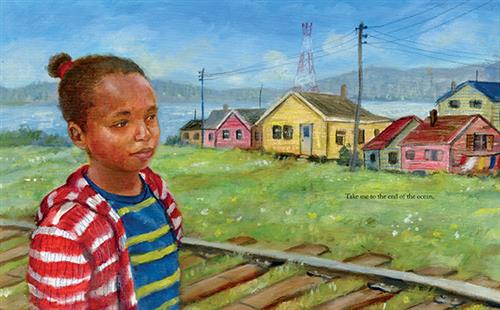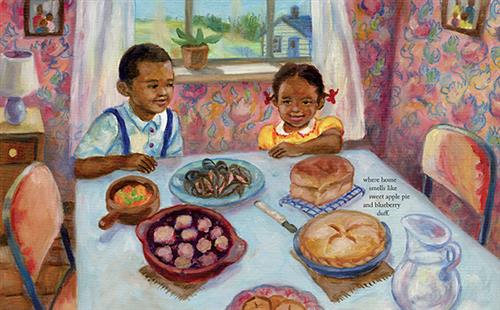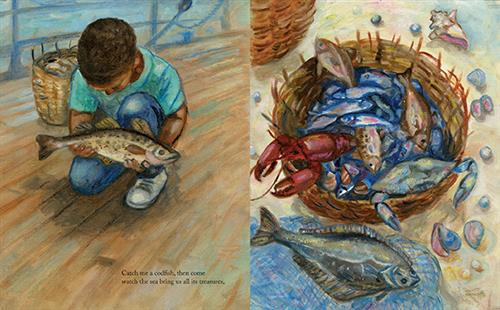Winner of the Marilyn Baillie Picture Book Award
Winner of the Lillian Shepherd Memorial Award for Excellence in Illustration
Finalist for a Governor General’s Literary Award, Young People’s Literature – Illustrated Books
Finalist for a Ruth and Sylvia Schwartz Children’s Books Award
When a young girl visits the site of Africville, in Halifax, Nova Scotia, the stories she’s heard from her family come to mind. She imagines what the community was once like —the brightly painted houses nestled into the hillside, the field where boys played football, the pond where all the kids went rafting, the bountiful fishing, the huge bonfires. Coming out of her reverie, she visits the present-day park and the sundial where her great- grandmother’s name is carved in stone, and celebrates a summer day at the annual Africville Reunion/Festival.
Africville was a vibrant Black community for more than 150 years. But even though its residents paid municipal taxes, they lived without running water, sewers, paved roads and police, fire-truck and ambulance services. Over time, the city located a slaughterhouse, a hospital for infectious disease, and even the city garbage dump nearby. In the 1960s, city officials decided to demolish the community, moving people out in city dump trucks and relocating them in public housing.
Today, Africville has been replaced by a park, where former residents and their families gather each summer to remember their community.
Key Text Features
historical context
references
Correlates to the Common Core State Standards in English Language Arts:
CCSS.ELA-LITERACY.RL.K.6
With prompting and support, name the author and illustrator of a story and define the role of each in telling the story.
CCSS.ELA-LITERACY.RL.1.3
Describe characters, settings, and major events in a story, using key details.
CCSS.ELA-LITERACY.RL.1.4
Identify words and phrases in stories or poems that suggest feelings or appeal to the senses.
CCSS.ELA-LITERACY.RL.1.7
Use illustrations and details in a story to describe its characters, setting, or events.
Winner of the Marilyn Baillie Picture Book Award
Winner of the Lillian Shepherd Memorial Award for Excellence in Illustration
Finalist for a Governor General’s Literary Award, Young People’s Literature – Illustrated Books
Finalist for a Ruth and Sylvia Schwartz Children’s Books Award
When a young girl visits the site of Africville, in Halifax, Nova Scotia, the stories she’s heard from her family come to mind. She imagines what the community was once like —the brightly painted houses nestled into the hillside, the field where boys played football, the pond where all the kids went rafting, the bountiful fishing, the huge bonfires. Coming out of her reverie, she visits the present-day park and the sundial where her great- grandmother’s name is carved in stone, and celebrates a summer day at the annual Africville Reunion/Festival.
Africville was a vibrant Black community for more than 150 years. But even though its residents paid municipal taxes, they lived without running water, sewers, paved roads and police, fire-truck and ambulance services. Over time, the city located a slaughterhouse, a hospital for infectious disease, and even the city garbage dump nearby. In the 1960s, city officials decided to demolish the community, moving people out in city dump trucks and relocating them in public housing.
Today, Africville has been replaced by a park, where former residents and their families gather each summer to remember their community.
Key Text Features
historical context
references
Correlates to the Common Core State Standards in English Language Arts:
CCSS.ELA-LITERACY.RL.K.6
With prompting and support, name the author and illustrator of a story and define the role of each in telling the story.
CCSS.ELA-LITERACY.RL.1.3
Describe characters, settings, and major events in a story, using key details.
CCSS.ELA-LITERACY.RL.1.4
Identify words and phrases in stories or poems that suggest feelings or appeal to the senses.
CCSS.ELA-LITERACY.RL.1.7
Use illustrations and details in a story to describe its characters, setting, or events.
| Published By | Groundwood Books Ltd — Sep 1, 2018 |
| Specifications | 32 pages | 8.25 in x 10.25 in |
| Keywords | Halifax; Nova Scotia; |
|
Supporting Resources
(select item to download) |
Teacher's Guide |
| Written By |
SHAUNTAY GRANT is a descendant of Black Loyalists, Jamaican Maroons and Black Refugees who migrated to Canada some two hundred years ago. A writer and performance artist, she has won the Joseph S. Stauffer Prize, and she has published several picture books. Shauntay also lectures in the Creative Writing Program at Dalhousie University. Her professional degrees and training include the Master of Fine Arts program at the University of British Columbia, and the Bachelor of Journalism program at the University of King’s College. She lives in Halifax. |
| Illustrated by |
EVA CAMPBELL is an artist and illustrator who teaches visual art. She has exhibited her work in Canada, the US, the UK, Barbados and Ghana. Eva won the Children’s Africana Book Award for her illustrations in The Matatu by Eric Walters. She also illustrated Africville by Shauntay Grant, winner of the Marilyn Baillie Picture Book Award and the Lillian Shepherd Memorial Award for Excellence in Illustration, and a Governor General’s Literary Award finalist. Eva lives in Victoria. |
| Written By |
|
SHAUNTAY GRANT is a descendant of Black Loyalists, Jamaican Maroons and Black Refugees who migrated to Canada some two hundred years ago. A writer and performance artist, she has won the Joseph S. Stauffer Prize, and she has published several picture books. Shauntay also lectures in the Creative Writing Program at Dalhousie University. Her professional degrees and training include the Master of Fine Arts program at the University of British Columbia, and the Bachelor of Journalism program at the University of King’s College. She lives in Halifax. |
| Illustrated by |
|
EVA CAMPBELL is an artist and illustrator who teaches visual art. She has exhibited her work in Canada, the US, the UK, Barbados and Ghana. Eva won the Children’s Africana Book Award for her illustrations in The Matatu by Eric Walters. She also illustrated Africville by Shauntay Grant, winner of the Marilyn Baillie Picture Book Award and the Lillian Shepherd Memorial Award for Excellence in Illustration, and a Governor General’s Literary Award finalist. Eva lives in Victoria. |
| Audience | ages 4 to 7 / grades K to 2 |
| Reading Levels |
Guided Reading L
Fountas & Pinnel Text Level L Lexile AD480L |
| Key Text Features | historical context; references |
| Common Core |
CCSS.ELA-LITERACY.RL.K.6
CCSS.ELA-LITERACY.RL.1.7 CCSS.ELA-LITERACY.RL.1.4 CCSS.ELA-LITERACY.RL.1.3 |
Winner, Marilyn Baillie Picture Book Award, 2019
Winner, Lillian Shepherd Memorial Award for Excellence in Illustration, 2019
Short-listed, Governor General's Literary Award, Young People's Literature - Illustrated Books, 2019
Short-listed, Elizabeth-Mrazik Cleaver Award, 2018
Short-listed, Ruth and Sylvia Schwartz Children's Book Award, 2019
Short-listed, Lieutenant Governor of Nova Scotia Masterworks Arts Award, 2019
Commended, CBC Books Best Canadian YA and Children’s Literature, 2018
“This story celebrates the beauty and joy of the community seen through a child’s eyes. . . . There is both pride and longing expressed in the lyrical text, and the vibrant colors and friendly compositions of the oil and pastel illustrations immerse readers in this community.” — School Library Journal
“Shauntay Grant’s writing is graceful ... She reaches out to young readers and invites them in ... Visually, Africville is gorgeous. Eva Campbell’s illustrations are arresting; the colours are warm and inviting, and her painterly style enhances the dreamlike quality of the story.” — Quill & Quire
“Through the poem, readers visit this sparkling seaside community . . .. Grant's evocative descriptions are perfectly matched in tone and timbre with Campbell's vibrant oil-and-pastel renderings of the town and its residents.” — Booklist
“The writing is spare but emotional, and the art brings the community to life. A loving tribute to a history that should not be forgotten.” — Kirkus Reviews
“[Shauntay] Grant’s perfectly paced free verse poetry has a gentle, hypnotic quality that flows through the narrative and invites the reader to savour each word and the myriad images the words evoke. Eva Campbell’s illustrations are bold, bright and filled with energy and motion. . . . [A] vivid portrait of what Africville once was.” — Atlantic Books Today
“The simplicity of [Shauntay Grant’s] story engages readers of all ages and backgrounds, and it brings to light a dark period in history in a completely accessible and very beautiful way. There is a melody to Grant’s poetry that entrances, and, when paired with Eva Campbell’s vivid illustrations, the former thriving community comes to life. . . . Africville is destined to become a picture book classic . . .” — CM: Canadian Review of Materials
“The reader travels on a special journey in both text and visual memories in Africville. . . . Africville is a delightful book for classrooms and public libraries looking for a gentle storybook as well a tribute to the history of a place that should not be forgotten.” — Resource Links
“[A] gorgeous and radiant ode.” — Vancouver Writers Fest




